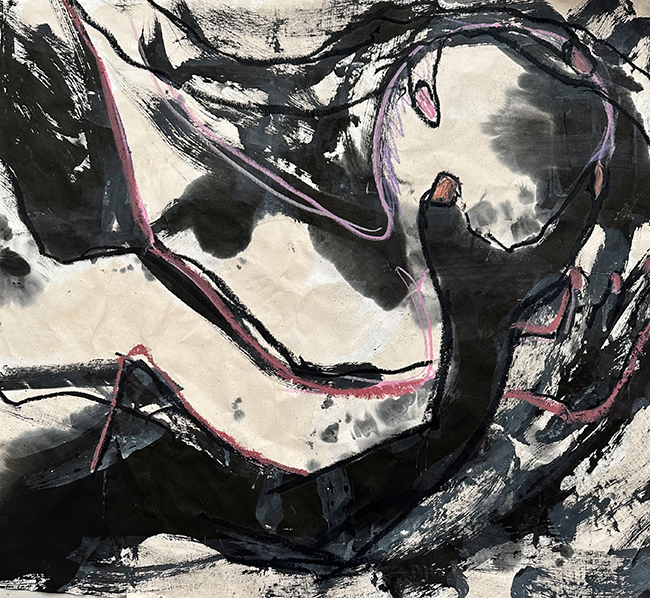Vicki Genberg is a multifaceted American artist whose life and work span continents and cultures, residing in both Kuala Lumpur, Malaysia, and Verbier, Switzerland. Her educational background, with a BFA from the School of Visual Arts in New York and an MFA from RMIT in Melbourne in conjunction with the Hong Kong Art School, has provided her with a diverse palette of influences and techniques that she blends into her art.

Genberg’s work is profoundly influenced by her environments—each location adds a layer to her canvas of experiences. The stark contrasts between the rugged, imposing Alps and the bustling, vibrant scenes of Hong Kong have shaped her into an artist who is as versatile as she is insightful.
Living in the Alps, Genberg was surrounded by the overwhelming force of nature—its beauty and its brutality. This proximity to the natural elements, the witnessing of life and death in such a primal setting, imbues her work with a raw, elemental power. It’s here in the mountains where she confronts the themes of nature’s supremacy and human vulnerability, themes that recur throughout her art.
In contrast, her experience in Hong Kong introduced her to a different set of artistic challenges and opportunities. The scarcity of traditional Western materials like oil paints led her to explore and incorporate local materials such as Chinese ink, paper, fabric, and even house paint into her work. This shift not only highlights her adaptability but also her ability to deeply engage with and respect the cultural context of her surroundings.
One of Genberg’s notable works, “Mind Game,” exemplifies her thematic focus on the complexities of human interaction and power dynamics. The piece features a dramatic depiction of a head—either being grasped, grabbed, or cradled, the interpretation is up to the viewer. This ambiguity is intentional, inviting the audience to ponder the relationships and power plays at work. “Mind Game” delves into the psychology of dominance, exploring how it is established, maintained, and manipulated in various social contexts.
The image serves as a metaphor for the psychological strategies employed in human relationships, be they personal, professional, or purely theoretical. Who holds the power? What strategies do they use to maintain this power? Genberg doesn’t provide easy answers but instead offers a visual arena where these questions can be contemplated and debated.
Genberg’s artistic language is as much about the medium as it is about the message. Her use of unconventional materials not only sets her apart but also comments on the necessity of adaptation—both in art and in life. This adaptability, driven by her cross-continental life, allows her to seamlessly integrate diverse artistic traditions into a coherent personal style that is both reflective and critical.
Her art is not just a representation of her experiences but also an invitation to the viewer to engage with broader questions about environment, material, and the human condition. It is this engagement that Genberg seems to value most—art as a dialogue, a medium through which ideas and experiences are exchanged and understood anew.
In today’s globalized world, where cultures intertwine more closely than ever, Genberg’s work stands out for its ability to bridge worlds through the universal language of art. Whether through the contemplative solitude of the Alps or the bustling streets of Hong Kong, she captures the essence of her environments and the people within them, offering viewers a chance to reflect on their own places in the world.
Vicki Genberg’s works, rich with cultural narratives and material innovation, invite us into a world where art transcends geographic and psychic borders, challenging us to think deeply about the forces that shape our lives and our relationships. Her exhibitions are more than just displays; they are vibrant dialogues with the audience, asking viewers to reflect on their own cultural identities and the interconnectedness of our global community. Each piece she creates is a bridge, linking disparate worlds through a shared visual language, and offering insight into the complex tapestry of human experience. Her art not only decorates a space but also imbues it with meaning and purpose, encouraging a closer examination of the nuances that define and distinguish our shared humanity.

